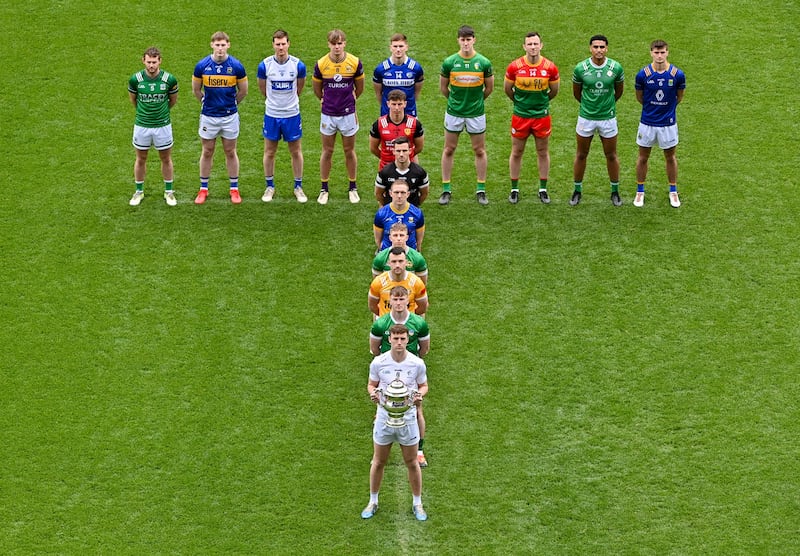Thirty years ago, the GAA was learning about how to fit in with television sports schedules. Ireland’s first match at the 1994 World Cup was played on Saturday, June 18th and ended in a momentous win over soccer heavyweights Italy in Giants Stadium.
“No longer triers, now contenders,” this newspaper excitably headlined its sports section.
Earlier that afternoon, Dublin played Kildare in the Leinster championship. It was an unusual fixture in that Saturdays were used sparingly, generally for replays. Croke Park was mid-reconstruction at the time and with no Cusack Stand, the capacity was reduced to just under 35,000.
Despite hopes of a sell-out, even the revised capacity wasn’t troubled, as 23,084 turned up for a surprising draw that outsiders Kildare could have won. A fortnight later, the crowd was actually down for the replay, at 22,569.
Ireland’s presence at an international soccer tournament — still the one sporting context that completely absorbs public interest — was something the GAA was getting used to. Gone was the crackpot defiance of putting on championship fixtures in direct opposition to Ireland’s matches that briefly flourished in Ulster.
The GAA learned to be more nimble, adapt and accept that when Ireland qualifies for these tournaments — and it hasn’t been as often as perhaps originally feared in the Jack Charlton era — the oxygen gets sucked out of the whole sports atmosphere in the country.
By Euro 2016, eight years ago, Croke Park was sticking France v Ireland on the big screen before Dublin played Meath in the Leinster semi-final.
International tournaments, with or without Ireland, are big business for television companies. Among the complaints about the clash of media obligations that led to last Sunday’s fiasco at Central Council, was that no Irish teams were competing in either the URC final or Euro 24.

Would that such metrics could be so easily applied. RTÉ isn’t in the business of signing up to pointless obligations. The rugby deal gives them and TG4 terrestrial access to Irish teams’ matches throughout the season with a reasonable chance that there’ll be one in the final, which they are contractually obliged to show live with build-up.
Those agreements don’t work if one party can skip the bits that don’t suit them, like having to show the Bulls v Glasgow final live from Pretoria rather than Munster v Leinster live from Limerick.
Similarly, RTÉ signs up for Euro 24 and has to show all matches. And why wouldn’t they, given the audiences even allowing for competing transmission on British stations?
The three most recent soccer tournaments — the 2022 and 2018 World Cups and Euro 2020, held in 2021 — have provided RTÉ with top-five spots in the yearly ratings list.
In 2018, the World Cup semi-final between England and Croatia was the fourth most watched broadcast on RTÉ that year and outperformed both All-Ireland finals.
So, when the GAA scheduled the All-Ireland hurling quarter-finals for this coming Saturday, there were two options: fix them for the afternoon and evening and let them go ahead without television coverage or play them early.
The consequences for the hurling quarter-finals are that they are inconvenient for spectators and television audiences alike. Cork hurlers are on a roll and will bring crowds but probably not as big as might have been the case with a more normal throw-in.
There is also no guarantee that they will stick around for the Clare v Wexford match.

The GAA will likely revisit the issue of scheduling the quarter-finals. Hurling supporters tend to be more traditional and prefer Sunday afternoon matches. The quarter-finals have been held on a Saturday for the past four years but before that Sundays were used – and from 2016 back, exclusively.
Clearing this Sunday for the Tailteann Cup was one of the core assurances given to counties when the Tier 2 football championship was being introduced. A whole day dedicated to the semi-finals with live television coverage was one of the undertakings given as proof of how seriously the new competition would be taken.
At the time there were misgivings expressed that similar promises had been made about previous tiered championships, such as the Tommy Murphy Cup, and that those reassurances had incrementally disappeared.
GAA president Jarlath Burns had been alerted to dissatisfaction among hurling counties at the loss of profile for the quarter-finals, during consultations with the provinces about possible changes to the football championship.
His convening of the Central Council to discuss swapping the quarter-finals with the Tailteann semi-finals was an extraordinary move. Whatever about taking up the issue a few weeks ago, the concept of shifting a football double bill forward by 24 hours at such short notice was bound to cause consternation.
It did and Sligo in particular, vehemently opposed the démarche.
Burns openly acknowledged the dilemma as “a contest between which are we going to nurture and promote more”, which could hardly have made the football counties feel equally valued when the fixtures calendar had already decided the issue.
Wexford also had reasons for seeking deferral, as the national under-14 hurling festival Féile na nGael is being hosted by the county this weekend. But a clash between Féile and a county’s championship match is nothing new — it could happen again next week if Mayo reach the football quarter-finals.
Although clearly not ideal, it is another consequence of the compressed season.
It also perhaps underlines that the idea of ring-fencing dates and guaranteeing television coverage for pet projects needs revision. You can’t force people to be interested in Tier 2 football and if the attempts to do so are interfering with core offerings, it’s time for a reset.
















